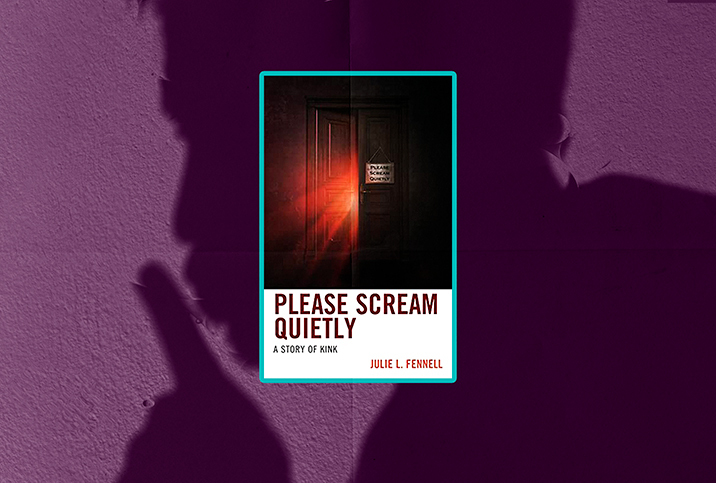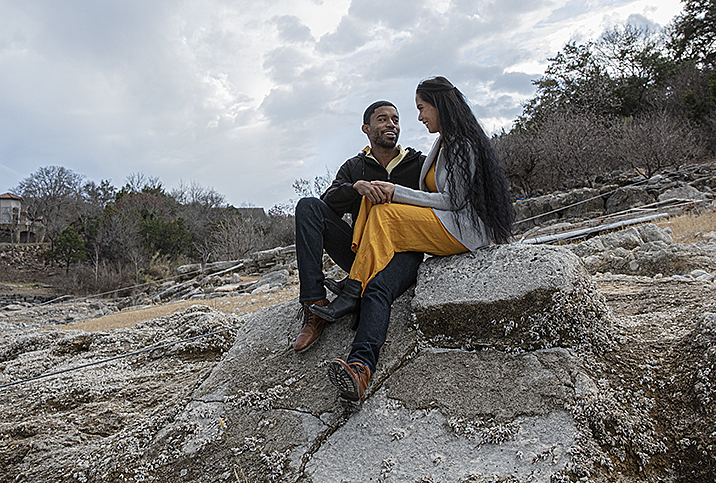Between the Pages: 'Please Scream Quietly' Dives Into Sexploration

Giddy recently had the opportunity to catch up with Julie Fennell, Ph.D., author of "Please Scream Quietly: A Story of Kink," published by Rowman & Littlefield. An associate professor of sociology at Gallaudet University in Washington, D.C., and a self-identified kinkster, Fennell presents an engrossing portrayal of the BDSM subculture.
The catch-all term BDSM—bondage and discipline, dominance and submission, sadism and masochism—is often misunderstood and maligned. Drawing on years of firsthand observations and experiences, in-depth interviews with kinksters and personal surveys, Fennell sought to answer questions in her book, such as "How do kinksters construct socially meaningful identities?" and "What does it mean to be kinky?"
In this exclusive Q&A, Fennell dispels myths about BDSM, discusses what draws people to "the Scene," and provides advice for the kink-curious.
Editor's note: This interview has been edited for length and clarity.
What are some misconceptions about BDSM?
Fennell: In general, people outside of "the Scene," the BDSM subculture that is a very nebulous concept, tend to understand BDSM in some particular ways. People tend to think BDSM is either very dressed up, very costumed, or they think it's very violent, which plenty of it is, but a lot of it isn't. Or, because so many of the popular cultural portrayals emphasize female dominance and male submissives, people sometimes mistakenly think that's most of what goes on in the culture. In fact, a big part of why pro dommes, which is to say, women who get paid, are so common is because unpaid female dommes are actually very uncommon.
The National Coalition for Sexual Freedom repeatedly emphasizes on their website the idea that everything that goes on in BDSM is consensual. If it's not consensual, it's abuse. People are very cautious of that. I think there are plenty of people who do not understand the distinction and think people who are doing BDSM are just in an abusive relationship and are lying to themselves about it. It is complicated by the fact that sometimes that's true. I've definitely met people who are in BDSM relationships and they later felt like they were being abused.
The BDSM subculture puts a really strong emphasis on consent that is not very present in a lot of the wider vanilla culture.
Bad relationships among kinky people happen just like they do among vanilla people. But responsible kinksters put a lot of safeguards in place to try to keep that from happening. A big part of what trying to do BDSM well means is trying to be reflexive and conscious about those things in a way a lot of vanilla people just aren't.
The BDSM subculture puts a really strong emphasis on consent that is not very present in a lot of the wider vanilla culture. A big part of that comes from alcohol and drug use. So many of the casual sexual encounters that occur in vanilla culture seem to happen while one or both people are intoxicated; we don't have great numbers on that. In the BDSM subculture, that's very heavily stigmatized, which I think allows for a much more conscientious approach to consent.
I assume some of what this comes from is people in the vanilla culture imagining these sexual encounters occurring the way they do in their own lives. You went out to a club and you got drunk, and you came home and tied someone up and had sex with them. The reality of casual relationships in kinky relationships is not that. Usually, there's a strong rule against kinking and drinking. I think a lot of people in the BDSM culture use BDSM as their social lubricant instead of drugs or alcohol. In general, it just promotes a much more conscientious approach to consent and how to do and get consent well. This is not to say by any means it's always perfect; it is not.
What is considered kinky?
My half-joke is, "Kinky is whatever kinky people say it is." To some degree, vanilla society gets to define kink, but that's very vague because vanilla society doesn't have any conclaves on that. Basically, if the people who go to BDSM events say it's kinky, then it is. I struggle to come up with any particular definition.
There are certainly things that are popular among kinky people. We live in a society where 50 percent of women admit on a survey that they're sexually aroused reading about rape fantasies. That's pretty kinky, I think, by anybody's definition. If that's normal by a sociological definition, that makes it very hard to say that's kinky. Obviously, it's kinky to put it into practice because most people don't try that.
It's a real struggle to define BDSM when it's constantly evolving, especially because it mostly gets defined as what is not vanilla sex. I find it pretty unconvincing that boxing and MMA [mixed martial arts] are not kinky. They look kinky to me. These are people who are doing things to each other consensually that are very painful. We don't define it as BDSM. The things we do put in the non-kinky box is interesting to me sociologically compared to the ones we don't.
I think it just comes down to intention. Lots of people say they're doing BDSM and they're not getting something sexual from it or anything particularly erotic. So what is it they're getting from it? They talk about these various primal urges; there's a long list in the book. What separates people doing sports from BDSM? And a lot of kinksters have used sports as their metaphor for why BDSM should be more accepted, that it's just not that different from sports.
It largely comes down to focusing on pain as a form of pleasure and/or well-negotiated trappings of dominance and submission in a relationship or an emphasis on restraint and constraint. Are these things necessarily about sex? No. Quite a lot of asexuals participate. It's really hard to say what this is really about.
Based on your interviews, what did you find commonly draws people to the Scene?
The BDSM scene is not very active and large outside of big cities. So if you don't live in a big city, it's usually pretty hard to get involved with it.
I was living in Washington, D.C. Part of how I got involved in the BDSM scene is I wanted to be polyamorous and get involved in the polyamorous community. In Washington, D.C., the BDSM scene is so large and old that it's barely distinct from the polyamorous community, so getting involved in the poly community basically meant getting involved in the BDSM scene. There are other parts of the country where that's not the case.
Dating someone who is already involved in the Scene is a common pathway into it. Having friends who are involved in the Scene is a common way into it. It was not at all uncommon to be involved in one of the adjacent subcultures as a gateway to the BDSM culture. Adjacent subcultures include Renaissance fair, burner [Burning Man], pagan and polyamorous. Those are the biggest ones.
Of course, plenty of people are very motivated by the internet nowadays. My older respondents said back in the day there were advertisements in the newspaper or the back of porn magazines. It is an intimidating thing to show up alone to BDSM events. People do it, but it can be very scary. Showing up with a friend or a partner is much less intimidating. If you have a very good Scene, a group will often run BDSM 101 nights that are designed to help new people become more comfortable and learn the norms.
What advice do you have for the kink-curious?
One of the best things is to explore a little bit online. Look around and try to get a sense for the things that are actually appealing to you. Be very cautious about who you talk to because that can lead you down some scary roads. If you're fortunate enough to live in a big city with a thriving BDSM scene, it's great to get involved with those organizations.
Start going to classes first. Try to learn things. Go to BDSM 101 nights. Read books and how-to manuals. Network with people who are more experienced and who can put you in touch with other people who actually know what they're doing.
I always recommend trying to get involved with your local public BDSM scene, but that is advice that only applies in big cities. Online resources, such as classes taught by educators on Kink Academy are very valuable. I learned some things off that website myself. Treat it as a learning process. BDSM can be a very fun hobby that you share with your partner.


















